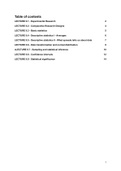Summary
Summary of lectures - IPRES block 2
- Course
- Institution
In this document you will find detailed notes from all lectures of the second block. These notes helped me score the highest grades of the 2019/2020 class with 8.4 in the final exam. Pay attention to the details and connect the dots of this summary and you will do well on your exam, assignment etc....
[Show more]



